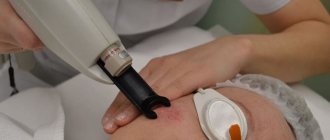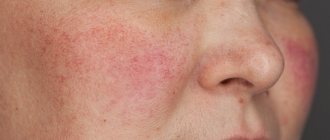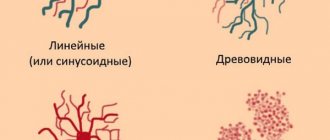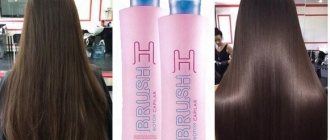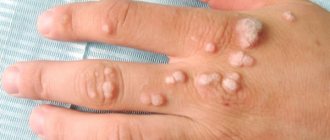Removing blood vessels on the face with a laser is an effective and safe method for eliminating aesthetic skin imperfections, which is widely popular all over the world.
Modern high-tech lasers “solder” dilated vessels quickly and painlessly without damaging the epidermis and without a long rehabilitation period.
In a medical clinic in St. Petersburg, laser removal of blood vessels on the face is carried out using the QUANTA SYSTEM DUETTO device, which allows you to obtain an instant visible result after the first procedure.
Thanks to the dynamic skin cooling system, laser coagulation of blood vessels occurs without excessive heating of adjacent healthy tissue, which in turn minimizes the risk of burns, pigmentation disorders or scar formation.
In addition, this technology allows you to eliminate pain during the procedure and carry it out without local anesthesia, even on sensitive areas of the face, such as the wings of the nose or the skin of the cheeks.
Laser removal of blood vessels for children
In children's clinics, lasers are used to eliminate congenital pathologies. Hemangioma is a benign tumor that looks like a birthmark. This is a vascular formation that disappears on its own by the first year of life, but not always. And then such education interferes with the full development of the child:
- Grows uncontrollably;
- Disfigures appearance;
- May lead to disability.
In difficult cases, surgery cannot be avoided. In the rest, due to the young age of the patient, non-invasive techniques are used. The cost of laser vessel removal in children is higher than in adults, but the price is justified by its high efficiency.
Is it possible to get rid of blood vessels forever?
Under the influence of various aggressive factors (frequent visits to baths and saunas, excessive alcohol consumption, harsh weather conditions - extreme heat, cold, stress) - due to increased pressure in the vascular bed, neighboring vessels may begin to appear again. Unfortunately, cosmetology does not fight the cause of blood vessels, but only the aesthetic manifestations. The cause of the appearance of blood vessels on the face is identified by other specialists, and sometimes it can be very difficult to find and eliminate it. Even in this case, the vessels do not disappear on their own, and the patient in this case also turns to a cosmetologist.
Is it painful to remove blood vessels with a laser?
The pain of the procedure depends on:
- Individual sensitivity of the patient;
- Laser type and power;
- Areas of vessel location;
- Use during the cryo installation procedure;
- Vessel diameter.
Absolutely everyone experiences discomfort when blood vessels are removed. Typically, patients feel moderate discomfort, which manifests itself:
- Warmth;
- Tingling;
- Light burning sensation.
Some compare laser flashes to electric shocks. When eliminating superficial vessels, local anesthesia is usually not used. But it is often practiced when working with childhood hemangiomas. Up to the use of general anesthesia where complete immobility of the child is necessary.
Vascular facial rejuvenation. Cuperosis
- Phlebology Center
- /
- Vascular facial rejuvenation. Cuperosis
The Phlebology Center uses the ultra-modern laser system CUTERA - XEO (USA) to remove blood vessels on the face, rosacea, and pigmentation. Ultra-modern equipment, experience and specialization of our doctors allow you to get quick and effective results.
The latest generation laser equipment allows you to remove vascular defects on the face without damaging the skin:
- eliminate dilated blood vessels, rosacea, diffuse redness,
- remove pigmentation,
- reduce expression lines and age wrinkles,
- increase skin turgor and elasticity.
Complex effect of Nd:YAG + LimeLight. The Nd:YAG 1064nm neodymium laser removes both superficial capillaries and deeper dilated vessels, which provides a high aesthetic result and a lasting effect. A special attachment with broadband light LimeLight quickly and painlessly eliminates diffuse redness, pigmentation and has a rejuvenating effect on facial skin.
Quick results. The full cosmetic effect is achieved on average in 1-2 procedures with an interval of 2-4 weeks. After treatment, there will be no traces left on the skin of the face, you can immediately return to normal life - no recovery period is required.
Safety . The CUTERA-XEO system makes it possible to individually adjust treatment parameters for the patient: power, pulse duration, depth and area of exposure, without affecting healthy areas of the skin.
Double cryoprotection . The built-in cooling of the CUTERA - XEO working head and the additional use of a Zimmer cryogenerator (Germany) reliably protect the treated skin area from intense laser exposure.
No limits. The Nd:YAG 1064nm neodymium laser does not affect melanin, so treatment can be carried out on any skin phototype.
Cost of services
| 1 | Laser removal of telangiectasia on the face - transdermal Nd:YAG 1064nm laser. One zone: forehead, nose, cheeks or chin | 3 750 5 000 |
| 2 | Laser removal of telangiectasia on the face - transdermal Nd:YAG 1064nm laser. Full face. | 10 500 14 000 |
| 3 | Rejuvenation with high-intensity pulsed light LimeLight. Treatment of diffuse redness, skin pigmentation in the neck or décolleté | 9 375 12 500 |
| 4 | Rejuvenation with high-intensity pulsed light LimeLight. Treatment of diffuse redness and skin pigmentation in the facial area | 10 875 14 500 |
| 5 | Laser removal of rosacea, telangiectasia on the face and treatment of diffuse redness and pigmentation of the facial skin. Transdermal laser Cutera Nd:YAG 1064 + LimeLight | 18 375 24 500 |
Contraindications to laser vessel removal
Laser removal of blood vessels is contraindicated if:
- Irritation or damage to the treated area;
- Inflammatory processes;
- Dermatitis;
- Diseases of the endocrine or cardiovascular systems;
- Diabetes;
- Vasculitis;
- Epilepsy;
- Infectious diseases, including periods of exacerbation of chronic ones;
- Oncological problems;
- Predisposition to the formation of keloid scars.
Exposure to the laser may interfere with the functioning of the pacemaker. At the preliminary consultation, they will also clarify about taking medications.
Some of the drugs are incompatible with the procedure:
- Dilating vessels;
- Blood thinners;
- Iron-containing;
- Antispasmodics;
- Corticosteroids (hormonal);
- Photosensitizing drugs;
- Retinoids, etc.
Contraindications include fresh tanning, peelings and any traumatic procedures. In such cases, it is better to postpone therapy until the skin is completely restored.
Causes of vascular pathology on the face
Dilation of capillaries is a cosmetic defect and does not pose a health hazard. As a rule, sensitive dry skin is prone to manifestations of rosacea and spider veins, but often those with oily skin have similar problems. Most often, the vascular network appears on the wings of the nose and cheeks.
There are several main causes of vascular pathologies of the face:
- Hereditary predisposition. The likelihood of vascular pathologies occurring is high if one of the parents suffered from this disease.
- Bad habits. Smoking and alcohol negatively affect the state of the vascular system, in particular small capillaries are affected. Often on the face of people who abuse alcohol. You can notice the characteristic vascular network.
- Tanning abuse. Excessive exposure to the scorching sun negatively affects the walls of blood vessels, weakening them and causing the formation of rosacea and spider veins.
- Kidney, liver and hypertension diseases. In this case, vascular pathology is a symptom of an internal disease.
- Cosmetology procedures. Violation of technology or procedures incorrectly selected for the skin type, use of aggressive agents - all this can thin and dehydrate the epidermis and provoke vasodilation.
- Temperature changes. Excessively low or high temperatures, as well as regular frostbite or prolonged exposure to elevated temperatures can cause the appearance of dilated capillaries in the facial skin.
How much does laser blood vessel removal cost?
The decisive price for laser vascular removal depends on the following factors:
- Localization and size of the problem area;
- Depth and severity of capillaries;
- Laser type;
- Prestige of the clinic;
- Doctor's experience.
The number of sessions also affects the total cost. Often a visible result appears after a single procedure, and if necessary, the problem is corrected by a second visit to a specialist.
In cases with rosacea or rosacea, the patient needs a long course - from 3 to 10 procedures with an interval of 2 to 4 weeks.
Average price for the service in clinics in Moscow and Moscow Region:
- Face - 6,000 rubles;
- Neckline—5600 RUR;
- Eyes - 10,000 rubles;
- Legs - 12,000 rubles;
- Hands - 7,000 rubles;
- Face, neck and décolleté — 8,600 rubles;
- 1 cm 2 - 1000 rub.
On average, the procedure for removing a spider vein with a diameter of 1.5 mm costs about 1,000 rubles. The cost of one flash unit can range from 100 to 1000 rubles.
How to remove capillary mesh on the face with maximum effect
Firstly , any doctor will tell you that one procedure will not be enough. And the point is not at all that the “stars” will not disappear the first time. You will see positive results after the first session. Depending on the intensity of rosacea, skin sensitivity, and individual characteristics of the body, you may be prescribed not one manipulation, but several. Even when you seem to have already gotten rid of the line of blood vessels appearing on your face, you will be advised to repeat the sessions after some time to consolidate the effect. The duration of the procedure is only a few minutes; you can first do a gentle peeling to remove excess epidermal cells and the fatty layer. A repeat session will be scheduled for you no earlier than in 3-4 months.
Questions from patients about the procedure of microsclerotherapy (removal) of spider veins
How much does modern microsclerotherapy for spider veins cost in Moscow?
A session of modern microsclerotherapy for spider veins in our Moscow city center costs 8 thousand rubles. You can find out more detailed information about the cost of treatment by phone or on our website page:.
Where is the best place to do microsclerotherapy for spider veins in Moscow?
Microsclerotherapy of spider veins in Moscow is best performed in a good city phlebology center, where they work according to modern European standards.
Is microsclerotherapy for telangiectasia and reticular veins performed simultaneously in Moscow?
Simultaneous microsclerotherapy sessions for telangiectasia and reticular veins are performed in the best Moscow clinics. This is a good procedure for quickly eliminating unsightly venous vessels.
Where can I read reviews about microsclerotherapy for spider veins and reticular veins?
Reviews from patients about microsclerotherapy for spider veins and reticular veins at the city phlebological center can be read on our website page: .
Cosmetic microsclerotherapy (microscleroobliteration) at the Moscow Phlebology Center
The microsclerotherapy method is deservedly called the “gold standard” for the removal of telangiectasia. Due to its minimal invasiveness, good patient tolerance and good clinical effect, the microsclerotherapy technique has taken its rightful place in modern phlebological practice. Cosmetic microsclerotherapy at the Moscow City Phlebological Center is performed by some of the best phlebologists in Moscow and Russia according to the most modern European standards.
Microsclerotherapy performed by phlebologist of the MIFC Raskin V.V.
We use the most advanced technologies to achieve not only a good clinical effect, but also the best aesthetic result.
Treatment methods for vascular defects in our clinic
- Removal of vascular defects photorejuvenation BBL (BBL). Coagulation of blood vessels is carried out without damaging surrounding tissues. The impact occurs pointwise. The doctor has full control over the cooling of the nozzle, which makes it possible to adjust the level of comfort of the procedure. Effectively removes both small and medium-sized vessels, effectively affects rosacea and port-wine stains on the face and body. Noticeable effect after the first procedure! Also, when treating large vessels, darkening of the vascular pattern occurs and subsequent exfoliation of the skin at the site of laser exposure.
- Neodymium laser for removing vascular defects even on dark skin.
What is telangiectasia (spider veins)
Telangiectasia (spider veins) is a persistent dilation of the smallest vessels of the skin: venules, arterioles and capillaries. The dilations of the smallest arteries rarely exceed a diameter of 0.2 mm and are predominantly red in color. These are red telangiectasia. To remove them, methods based on physical influence are used: radiofrequency and laser percutaneous exposure.
Types of spider veins
The clinical significance of telangiectasia is still discussed by leading European phlebologists. However, the contribution of telangiectasia to the development of symptoms of chronic venous insufficiency is rather exaggerated. The leading clinical significance of telangiectasia is a pronounced cosmetic defect. The so-called “blue” telangiectasias are dilated venules. It is these formations that are the leading reason for turning to an aesthetic phlebologist.
Prices:
Laser treatment of vascular pathology
| Removal of capillary hemangiomas on the body: | ||
| 1 mm | 100 rub. | |
| 2 mm | 300 rub. | |
| Removal of hemangioma on the face with a vascular laser | 1,000 rub. | |
| Cheek (one) | 6,000 rub. | |
| Nose wings (both sides) | 1,500 rub. | |
| Full nose | 3,000 rub. | |
| Chin | 3,000 rub. | |
| Single vessel (1 cm) | 1,000 rub. | |
| Local area (1 cm2) | 1,500 rub. | |
What is microsclerotherapy (removal) of telangiectasia (spider veins)?
Microsclerotherapy of telangiectasia (spider veins) is a modern cosmetic procedure aimed at removing small-diameter venous vessels by introducing substances (sclerosants) specially developed for this purpose into their lumen. The technique is based on the effect of a chemical burn of the inner wall of the asterisk with subsequent fibrosis of the vessel.
Microsclerotherapy procedure for telangiectasis
The microsclerotherapy procedure for telangiectasia is the “gold standard” for the removal of these vascular formations that arise from persistent dilatation of the smallest veins. This state of affairs is associated with a high aesthetic effect, safety and good tolerability of microsclerotherapy for telangiectasia.
Indications for spider vein removal in Moscow
The microsclerotherapy procedure in the presence of telangiectatic disease and reticular varicose veins in leading European clinics is carried out for cosmetic reasons. Often, when a large number of small vessels are removed, patients note an improvement not only in self-esteem, but also in sensations in the leg area. This is due to the elimination of the pathological venous bed and the elimination of symptoms of venous stagnation. Good phlebological practice involves diagnosing the venous system before starting microsclerotherapy procedures. Often, dilation of the smallest vessels is associated with disruption of the valve apparatus of the main saphenous veins, even without the formation of visible varicose veins. According to the standards of European phlebology clinics, such diagnostics are carried out for all patients, even if the complaints consist only of the presence of telangiectasis.
How is the microsclerotherapy procedure performed in a modern phlebological center in Moscow?
In our phlebological center, we use some of the best thinnest needles with laser sharpening of 27-30 G. Using these tools, skin punctures are made that are practically not felt by patients. The procedure is performed by an experienced phlebologist, who has not only thousands of procedures under his belt, but also a significant number of master classes on this technology.
Master class performed by phlebologist Semenov A.Yu. on microsclerotherapy
Sessions are carried out with the patient in a horizontal position. After puncturing the skin, the tip of the needle enters the vessel, the specialist slowly and carefully injects the drug, making sure that the vein does not overstretch and rupture.
After the session, sterile bandages are applied and compression stockings are put on. The patient is recommended to take a half-hour walk.
